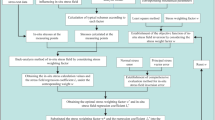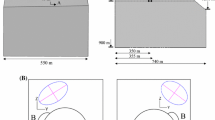Abstract
When the least square approach is used to solve regression coefficients during the back analysis of a virgin stress field, the multicollinearity among independent variables may cause negative, too large, or non-significant regression coefficients, which can lead to an unreasonable virgin stress field. To make the virgin stress field obtained by a back analysis more reasonable, it is proposed that the ridge regression can be used to solve regression coefficients if multicollinearity exists. In the ridge regression, a small constant term was added to all diagonal elements of the correlation matrix to eliminate multicollinearity. Then this constant term was determined by ridge traces, the residual sum of squares, variance inflation factors, and statistical significance tests. To show the feasibility of determining a virgin stress field by the ridge regression, it was applied to the Heai tunnel located in Huili County, Sichuan Province, China. Results show that the ridge regression can avoid negative, too large, or non-significant regression coefficients effectively, and the virgin stress field obtained by the ridge regression is more reasonable and reliable than that obtained by the least square approach.












Similar content being viewed by others
References
Álvarez-Fernández MI, González-Nicieza C, Argüelles A, Álvarez-Vigil AE (2011) Determination of the stress state in a rock mass subjected to excavation. Bull Eng Geol Environ 70(2):243–253
Anderson DR, Sweeney DJ, Williams TA, Camm JD, Cochran JJ (2017) Statistics for business and economics, 13th edn. Cengage Learning, Boston
Brown ET, Hoek E (1978) Trends in relationships between measured in-situ stresses and depth. Int J Rock Mech Min Sci Geomech Abstr 15(4):211–215
Chen SD, Tang DZ, Tao S, Xu H, Li S, Zhao JL, Ren PF, Fu HJ (2017) In-situ stress measurements and stress distribution characteristics of coal reservoirs in major coalfields in China: implication for coalbed methane (CBM) development. Int J Coal Geol 182:66–84
Chiliza SG, Hingston EDC (2018) Back analysis of an ancient rockslide at Lake Fundudzi, Limpopo Province, South Africa. Bull Eng Geol Environ 77(1):29–47
Esmaieli K, Hadjigeorgiou J, Grenon M (2013) Stability analysis of the 19A ore pass at Brunswick mine using a two-stage numerical modeling approach. Rock Mech Rock Eng 46(6):1323–1338
Figueiredo B, Cornet FH, Lamas L, Muralha J (2014) Determination of the stress field in a mountainous granite rock mass. Int J Rock Mech Min Sci 72:37–48
Ghorbani M, Sharifzadeh M (2009) Long term stability assessment of Siah Bisheh powerhouse cavern based on displacement back analysis method. Tunn Undergr Space Technol 24(5):574–583
Ghorbani E, Moosavi M, Hossaini MF, Assary M, Golabchi Y (2020) Determination of initial stress state and rock mass deformation modulus at Lavarak HEPP by back analysis using ant colony optimization and multivariable regression analysis. Bull Eng Geol Environ
Gunst RF, Webster JT (1975) Regression analysis and problems of multicollinearity. Commun Stat 4(3):277–292
Haimson BC, Lee MY, Song I (2003) Shallow hydraulic fracturing measurements in Korea support tectonic and seismic indicators of regional stress. Int J Rock Mech Min Sci 40(7):1243–1256
Han J, Zhang HW, Liang B, Rong H, Lan TW, Liu YZ, Ren T (2016) Influence of large syncline on in situ stress field: a case study of the Kaiping coalfield, China. Rock Mech Rock Eng 49(11):4423–4440
Hoerl AE, Kennard RW (1970a) Ridge regression: applications to nonorthogonal problems. Technometrics 12(1):69–82
Hoerl AE, Kennard RW (1970b) Ridge regression: biased estimation for nonorthogonal problems. Technometrics 12(1):55–67
Ju W, Wang K (2018) A preliminary study of the present-day in-situ stress state in the Ahe tight gas reservoir, Dibei Gasfield, Kuqa depression. Mar Petrol Geol 96:154–165
Ju W, Jiang B, Miao Q, Wang JL, Qu ZH, Li M (2018) Variation of in situ stress regime in coal reservoirs, eastern Yunnan region, South China: implications for coalbed methane production. AAPG Bull 102(11):2283–2303
Khademian Z, Shahriar K, Gharouni Nik M (2012) Developing an algorithm to estimate in situ stresses using a hybrid numerical method based on local stress measurement. Int J Rock Mech Min Sci 55:80–85
Klee G, Bunger A, Meyer G, Rummel F, Shen B (2011) In situ stresses in borehole Blanche-1/South Australia derived from breakouts, core discing and hydraulic fracturing to 2 km depth. Rock Mech Rock Eng 44(5):531–540
Kolivand F, Rahmannejad R (2018) Estimation of geotechnical parameters using Taguchi’s design of experiment (DOE) and back analysis methods based on field measurement data. Bull Eng Geol Environ 77(4):1763–1779
Kong P, Jiang LS, Shu JM, Sainoki A, Wang QB (2019) Effect of fracture heterogeneity on rock mass stability in a highly heterogeneous underground roadway. Rock Mech Rock Eng 52:4547–4564
Konstantinovskaya E, Malo M, Castillo DA (2012) Present-day stress analysis of the St. Lawrence lowlands sedimentary basin (Canada) and implications for caprock integrity during CO2 injection operations. Tectonophysics 518–521:119–137
Lee H, Ong SH (2018) Estimation of in situ stresses with hydro-fracturing tests and a statistical method. Rock Mech Rock Eng 51(3):779–799
Li G, Mizuta Y, Ishida T, Li H, Nakama S, Sato T (2009) Stress field determination from local stress measurements by numerical modelling. Int J Rock Mech Min Sci 46(1):138–147
Li F, Wang JA, Brigham JC (2014) Inverse calculation of insitu stress in rock mass using the surrogate-model accelerated random search algorithm. Comput Geotech 61:24–32
Li Y, Guo YH, Zhu WS, Li SC, Zhou H (2015) A modied initial in-situ stress inversion method based on FLAC3D with an engineering application. Open Geosci 7:824–835
Liu CL, Li G, Kuriyama K, Mizuta Y (2005) Development of a computer program for inhomogeneous modeling using 3-D BEM with analytical integration and its application to rock slope stability evaluation. Int J Rock Mech Min Sci 1(42):137–144
Liu YQ, Li HB, Luo CW, Wang XC (2014) In situ stress measurements by hydraulic fracturing in the Western route of south to north water transfer project in China. Eng Geol 168:114–119
Marquaridt DW (1970) Generalized inverses, ridge regression, biased linear estimation, and nonlinear estimation. Technometrics 12(3):591–612
McGarr A, Gay NC (1978) State of stress in the earth’s crust. Annu Rev Earth Planet Sci 6(1):405–436
McKinnon SD (2001) Analysis of stress measurements using a numerical model methodology. Int J Rock Mech Min Sci 38(5):699–709
McKinnon SD, Garrido de la Barra I (2003) Stress field analysis at the El Teniente mine: evidence for N–S compression in the modern Andes. J Struct Geol 25(12):2125–2139
Meng W, He C (2020) Back analysis of the initial geo-stress field of rock masses in high geo-temperature and high geo-stress. Energies 13(2):363
Montgomery DC, Peck EA, Vining GG (2012) Introduction to linear regression analysis, 5th edn. Wiley, London
Pei QT, Ding XL, Liu YK, Lu B, Huang SL, Fu J (2019) Optimized back analysis method for stress determination based on identification of local stress measurements and its application. Bull Eng Geol Environ 78(1):375–396
Qi CC, Fourie A (2018) A real-time back-analysis technique to infer rheological parameters from field monitoring. Rock Mech Rock Eng 51(10):3029–3043
Sharifzadeh M, Daraei R, Broojerdi MS (2012) Design of sequential excavation tunneling in weak rocks through findings obtained from displacements based back analysis. Tunn Undergr Space Technol 28:10–17
Vardakos S, Gutierrez M, Xia C (2016) Back-analysis of tunnel response from field monitoring using simulated annealing. Rock Mech Rock Eng 49(12):4833–4852
Wang Q et al (2001) Present-day crustal deformation in China constrained by global positioning system measurements. Science 294(5542):574–577
Xu WY, Zhang JC, Wang W, Wang RB (2014) Investigation into in situ stress fields in the asymmetric V-shaped river valley at the Wudongde dam site, Southwest China. Bull Eng Geol Environ 73(2):465–477
Yang CX, Wu YH, Hon T (2010) A no-tension elastic–plastic model and optimized back-analysis technique for modeling nonlinear mechanical behavior of rock mass in tunneling. Tunn Undergr Space Technol 25(3):279–289
Yang SX, Huang LY, Xie FR, Cui XF, Yao R (2014) Quantitative analysis of the shallow crustal tectonic stress field in China mainland based on in situ stress data. J Asian Earth Sci 85:154–162
Yazdani M, Sharifzadeh M, Kamrani K, Ghorbani M (2012) Displacement-based numerical back analysis for estimation of rock mass parameters in Siah Bisheh powerhouse cavern using continuum and discontinuum approach. Tunn Undergr Space Technol 28:41–48
Zhang QH, Zhong ZW, Gong BX (2000) Method of generating pure shear stress by adding boundary displacement and its application in back analysis for geostress field (in Chinese). J Yangtze River Sci Res Inst 17(2):34–36
Zhang LQ, Yue ZQ, Yang ZF, Qi JX, Liu FC (2006) A displacement-based back-analysis method for rock mass modulus and horizontal in situ stress in tunneling – illustrated with a case study. Tunn Undergr Space Technol 21(6):636–649
Zhang CQ, Feng XT, Zhou H (2012) Estimation of in situ stress along deep tunnels buried in complex geological conditions. Int J Rock Mech Min Sci 52:139–162
Zhang SR, Hu AK, Wang C (2016) Three-dimensional inversion analysis of an in situ stress field based on a two-stage optimization algorithm. J Zhejiang Univ Sci A 17(10):782–802
Zhao B (2015) GPS velocity field of CMONOC with respect to Eurasia
Zhao XG et al (2013) In-situ stress measurements and regional stress field assessment of the Beishan area, China. Eng Geol 163:26–40
Zhao XG et al (2015) In-situ stress measurements and regional stress field assessment in the Xinjiang candidate area for China’s HLW disposal. Eng Geol 197:42–56
Zhao JL, Tang DZ, Xu H, Li Y, Li S, Tao S, Lin WJ, Liu ZX (2016) Characteristic of in situ stress and its control on the coalbed methane reservoir permeability in the eastern margin of the Ordos Basin, China. Rock Mech Rock Eng 49(8):3307–3322
Zoback ML et al (1989) Global patterns of tectonic stress. Nature 341:291
Acknowledgments
This work was financially supported by the High Speed Railway and Natural Science United Foundation of China (U1734205).
Author information
Authors and Affiliations
Corresponding author
Ethics declarations
Conflict of interest
The authors declare that they have no conflict of interest.
Rights and permissions
About this article
Cite this article
Meng, W., He, C., Zhou, Z. et al. Application of the ridge regression in the back analysis of a virgin stress field. Bull Eng Geol Environ 80, 2215–2235 (2021). https://doi.org/10.1007/s10064-020-02043-y
Received:
Accepted:
Published:
Issue Date:
DOI: https://doi.org/10.1007/s10064-020-02043-y




